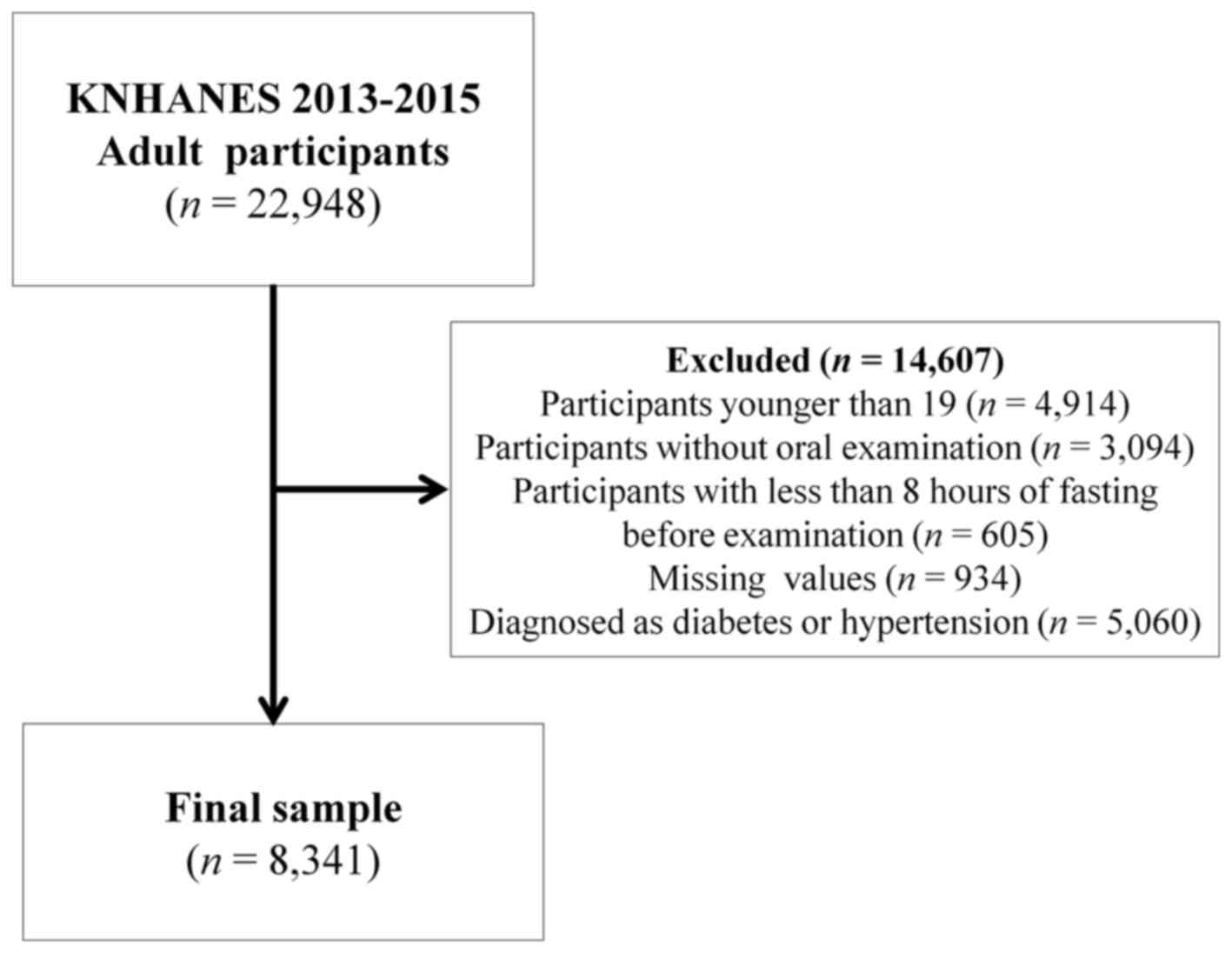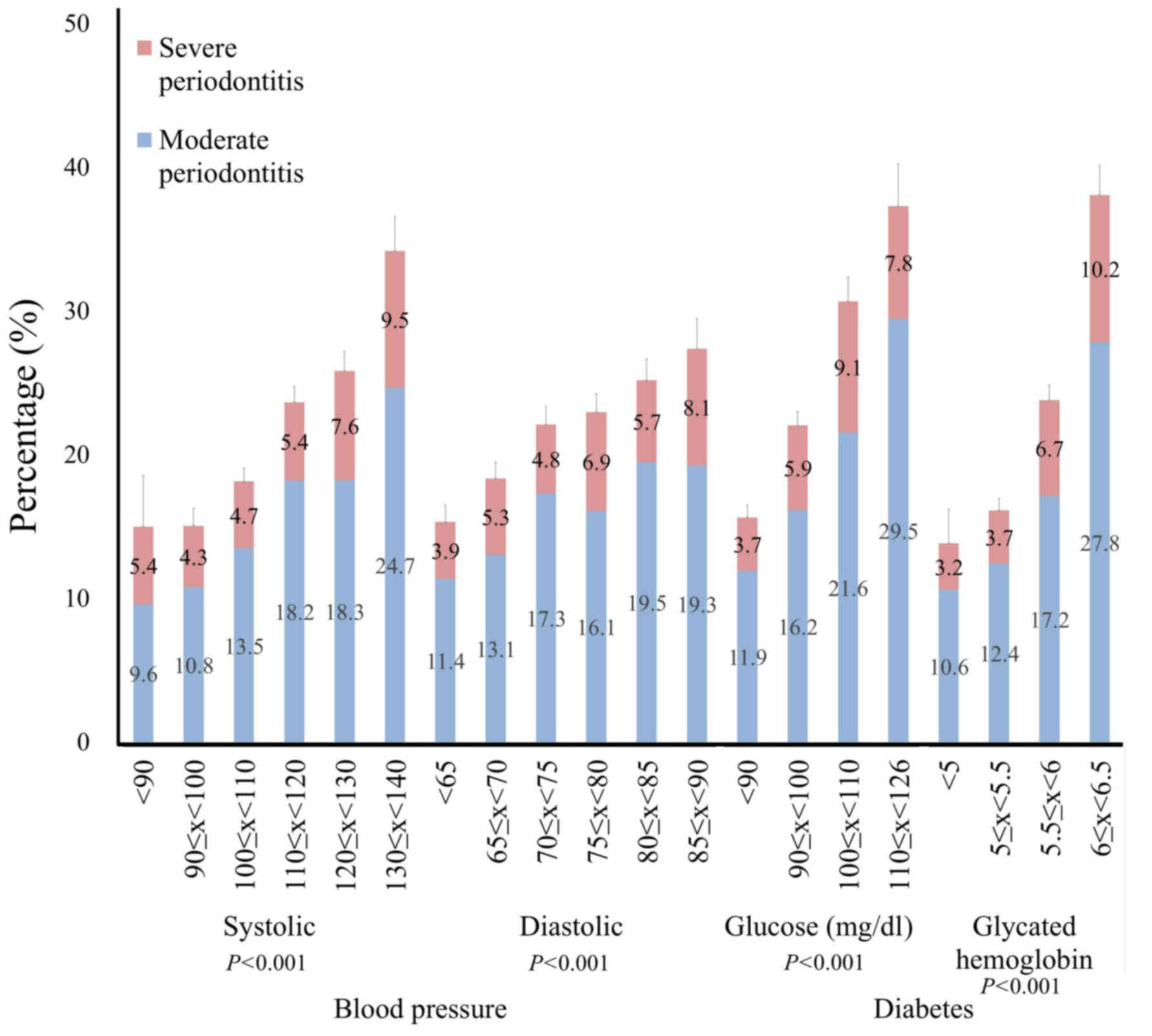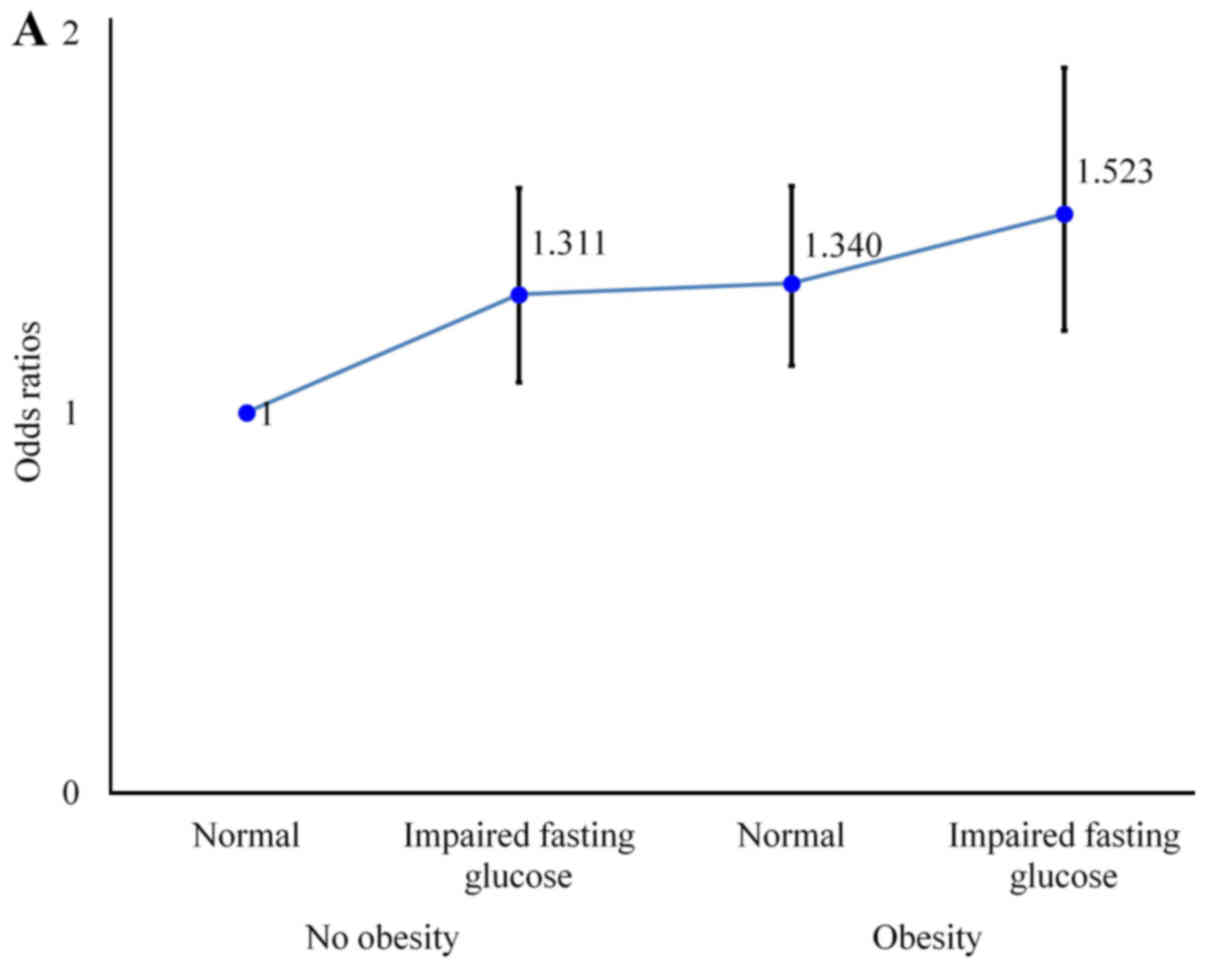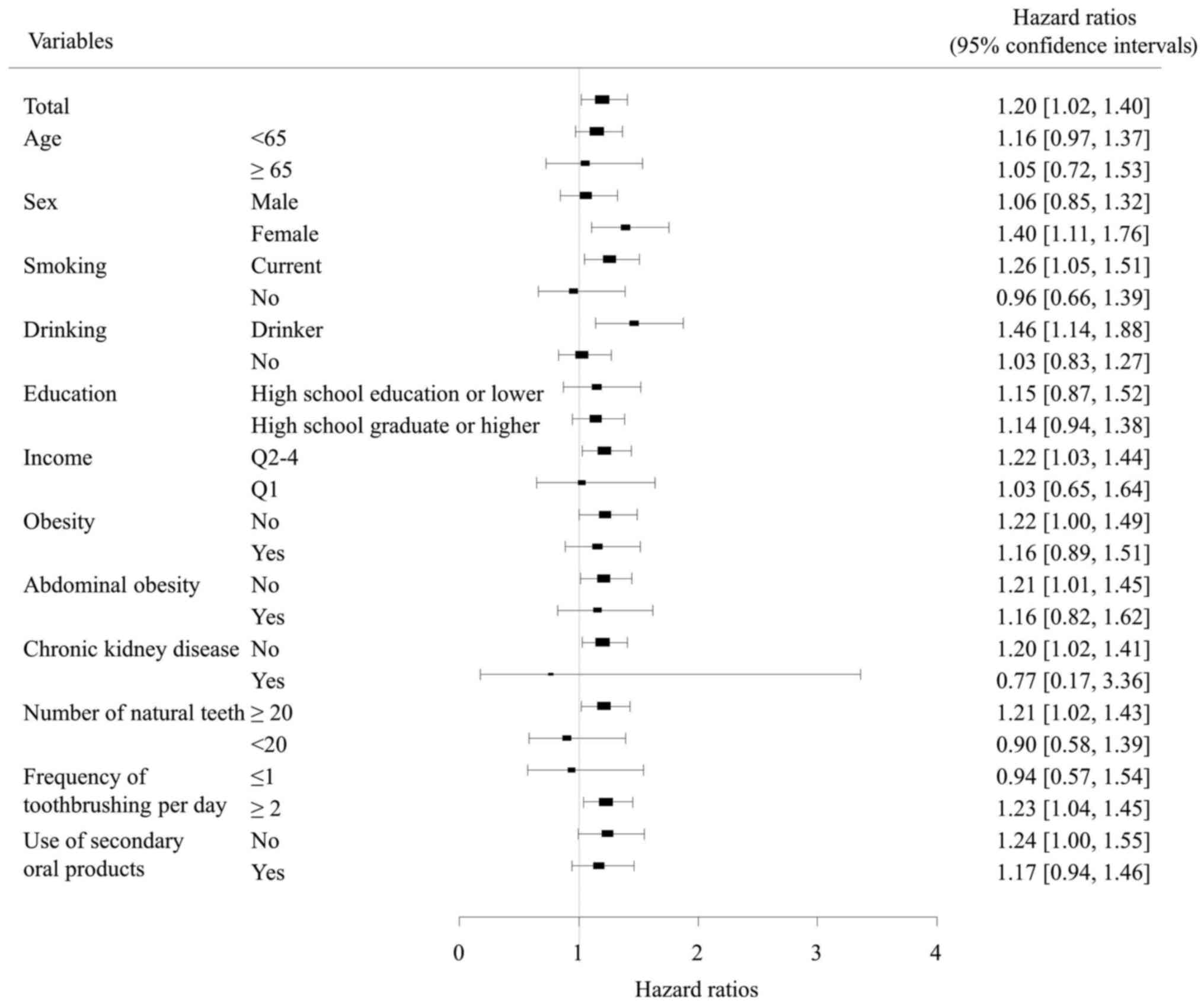|
1
|
Kim J and Amar S: Periodontal disease and
systemic conditions: A bidirectional relationship. Odontology.
94:10–21. 2006. View Article : Google Scholar : PubMed/NCBI
|
|
2
|
Tatsumi Y and Ohkubo T: Hypertension with
diabetes mellitus: Significance from an epidemiological perspective
for Japanese. Hypertens Res. 40:795–806. 2017. View Article : Google Scholar : PubMed/NCBI
|
|
3
|
Paizan Macedo ML and Vilela-Martin JF: Is
there an association between periodontitis and hypertension? Curr
Cardiol Rev. 10:355–361. 2014. View Article : Google Scholar : PubMed/NCBI
|
|
4
|
Choi HM, Han K, Park YG and Park JB:
Associations among oral hygiene behavior and hypertension
prevalence and control: The 2008 to 2010 Korea national health and
nutrition examination survey. J Periodontol. 86:866–873. 2015.
View Article : Google Scholar : PubMed/NCBI
|
|
5
|
Cho NH: Diabetes burden and prevention in
Korea and the Western Pacific Region. Diabetes Res Clin Pract. 106
Suppl 2:S282–S287. 2014. View Article : Google Scholar : PubMed/NCBI
|
|
6
|
Ha KH and Kim DJ: Current status of
managing diabetes mellitus in Korea. Korean J Intern Med.
31:845–850. 2016. View Article : Google Scholar : PubMed/NCBI
|
|
7
|
Cade WT: Diabetes-related microvascular
and macrovascular diseases in the physical therapy setting. Phys
Ther. 88:1322–1335. 2008. View Article : Google Scholar : PubMed/NCBI
|
|
8
|
Lee HY and Park JB: The Korean society of
hypertension guidelines for the management of hypertension in 2013:
Its essentials and key points. Pulse (Basel). 3:21–28. 2015.
View Article : Google Scholar : PubMed/NCBI
|
|
9
|
Amiri AA, Maboudi A, Bahar A, Farokhfar A,
Daneshvar F, Khoshgoeian HR, Nasohi M and Khalilian A: Relationship
between Type 2 diabetic retinopathy and periodontal disease in
iranian adults. N Am J Med Sci. 6:139–144. 2014. View Article : Google Scholar : PubMed/NCBI
|
|
10
|
Lakschevitz F, Aboodi G, Tenenbaum H and
Glogauer M: Diabetes and periodontal diseases: Interplay and links.
Curr Diabetes Rev. 7:433–439. 2011. View Article : Google Scholar : PubMed/NCBI
|
|
11
|
Tsakos G, Sabbah W, Hingorani AD, Netuveli
G, Donos N, Watt RG and D'Aiuto F: Is periodontal inflammation
associated with raised blood pressure? Evidence from a National US
survey. J Hypertens. 28:2386–2393. 2010.PubMed/NCBI
|
|
12
|
Nam GE, Kim do H, Cho KH, Park YG, Han KD,
Choi YS, Kim SM, Ko BJ, Kim YH and Lee KS: Estimate of a predictive
cut-off value for serum 25-hydroxyvitamin D reflecting abdominal
obesity in Korean adolescents. Nutr Res. 32:395–402. 2012.
View Article : Google Scholar : PubMed/NCBI
|
|
13
|
Wallace TM, Levy JC and Matthews DR: Use
and abuse of HOMA modeling. Diabetes Care. 27:1487–1495. 2004.
View Article : Google Scholar : PubMed/NCBI
|
|
14
|
Oh SW, Shin SA, Yun YH, Yoo T and Huh BY:
Cut-off point of BMI and obesity-related comorbidities and
mortality in middle-aged Koreans. Obes Res. 12:2031–2040. 2004.
View Article : Google Scholar : PubMed/NCBI
|
|
15
|
Lee S, Park HS, Kim SM, Kwon HS, Kim DY,
Kim DJ, Cho GJ, Han JH, Kim SR, Park CY, et al: Cut-off points of
waist circumference for defining abdominal obesity in the Korean
population. Korean J Obes. 15:1–9. 2006. View Article : Google Scholar
|
|
16
|
Jeon JY, Ko SH, Kwon HS, Kim NH, Kim JH,
Kim CS, Song KH, Won JC, Lim S, Choi SH, et al: Prevalence of
diabetes and prediabetes according to fasting plasma glucose and
HbA1c. Diabetes Metab J. 37:349–357. 2013. View Article : Google Scholar : PubMed/NCBI
|
|
17
|
Worede A, Alemu S, Gelaw YA and Abebe M:
The prevalence of impaired fasting glucose and undiagnosed diabetes
mellitus and associated risk factors among adults living in a rural
Koladiba town, northwest Ethiopia. BMC Res Notes. 10:2512017.
View Article : Google Scholar : PubMed/NCBI
|
|
18
|
Kim YH, Kim DH, Lim KS, Ko BJ, Han BD, Nam
GE, Park YG, Han KD, Kim JH and Cho KH: Oral health behaviors and
metabolic syndrome: The 2008–2010 Korean National Health And
Nutrition Examination Survey. Clin Oral Investig. 18:1517–1524.
2014. View Article : Google Scholar : PubMed/NCBI
|
|
19
|
Park JB, Han K, Park YG and Ko Y:
Association between alcohol consumption and periodontal disease:
The 2008 to 2010 Korea national health and nutrition examination
survey. J Periodontol. 85:1521–1528. 2014. View Article : Google Scholar : PubMed/NCBI
|
|
20
|
Alberti KG and Zimmet PZ: Definition,
diagnosis and classification of diabetes mellitus and its
complications. Part 1: diagnosis and classification of diabetes
mellitus provisional report of a WHO consultation. Diabet Med.
15:539–553. 1998. View Article : Google Scholar : PubMed/NCBI
|
|
21
|
James PA, Oparil S, Carter BL, Cushman WC,
Dennison-Himmelfarb C, Handler J, Lackland DT, LeFevre ML,
MacKenzie TD, Ogedegbe O, et al: 2014 evidence-based guideline for
the management of high blood pressure in adults: Report from the
panel members appointed to the Eighth Joint National Committee (JNC
8). JAMA. 311:507–520. 2014. View Article : Google Scholar : PubMed/NCBI
|
|
22
|
Arguedas JA, Leiva V and Wright JM: Blood
pressure targets for hypertension in people with diabetes mellitus.
Cochrane Database Syst Rev CD008277. 2013. View Article : Google Scholar
|
|
23
|
Zhang Y, Lee ET, Devereux RB, Yeh J, Best
LG, Fabsitz RR and Howard BV: Prehypertension, diabetes, and
cardiovascular disease risk in a population-based sample: The
Strong Heart Study. Hypertension. 47:410–414. 2006. View Article : Google Scholar : PubMed/NCBI
|
|
24
|
Julius S, Nesbitt SD, Egan BM, Weber MA,
Michelson EL, Kaciroti N, Black HR, Grimm RH Jr, Messerli FH,
Oparil S, et al: Feasibility of treating prehypertension with an
angiotensin-receptor blocker. N Engl J Med. 354:1685–1697. 2006.
View Article : Google Scholar : PubMed/NCBI
|
|
25
|
Qaseem A, Wilt TJ, Rich R, Humphrey LL,
Frost J and Forciea MA: Clinical Guidelines Committee of the
American College of Physicians and the Commission on Health of the
Public and Science of the American Academy of Family Physician:
Pharmacologic treatment of hypertension in adults aged 60 years or
older to higher versus lower blood pressure targets: A clinical
practice guideline from the american college of physicians and the
american academy of family physicians. Ann Intern Med. 166:430–437.
2017. View
Article : Google Scholar : PubMed/NCBI
|
|
26
|
Xie X, Atkins E, Lv J, Bennett A, Neal B,
Ninomiya T, Woodward M, MacMahon S, Turnbull F, Hillis GS, et al:
Effects of intensive blood pressure lowering on cardiovascular and
renal outcomes: Updated systematic review and meta-analysis.
Lancet. 387:435–443. 2016. View Article : Google Scholar : PubMed/NCBI
|
|
27
|
Arora N, Papapanou PN, Rosenbaum M, Jacobs
DR Jr, Desvarieux M and Demmer RT: Periodontal infection, impaired
fasting glucose and impaired glucose tolerance: Results from the
continuous national health and nutrition examination survey
2009–2010. J Clin Periodontol. 41:643–652. 2014. View Article : Google Scholar : PubMed/NCBI
|
|
28
|
Islam SK, Seo M, Lee YS and Moon SS:
Association of periodontitis with insulin resistance, beta-cell
function and impaired fasting glucose before onset of diabetes.
Endocr J. 62:981–989. 2015. View Article : Google Scholar : PubMed/NCBI
|
|
29
|
Song IS, Han K, Ryu JJ and Park JB:
Association between underweight and tooth loss among Korean adults.
Sci Rep. 7:415242017. View Article : Google Scholar : PubMed/NCBI
|
|
30
|
Hong M, Park JB, Kim YS, Lee DH, Kim H,
Lee JI, Ahn HS, Sohn TS, Lee TK, et al: Association between
Cockroach-specific Immunoglobulin E and periodontitis in Korean
male adults Based on Korean National Health And Nutrition
Examination Survey. Sci Rep. 7:463732017. View Article : Google Scholar : PubMed/NCBI
|
|
31
|
Han K, Ko Y, Park YG and Park JB:
Associations between the periodontal disease in women before
menopause and menstrual cycle irregularity: The 2010–2012 Korea
national health and nutrition examination survey. Medicine
(Baltimore). 95:e27912016. View Article : Google Scholar : PubMed/NCBI
|
|
32
|
Choi HM, Han K, Park YG and Park JB:
Associations between the number of natural teeth and renal
dysfunction. Medicine (Baltimore). 95:e46812016. View Article : Google Scholar : PubMed/NCBI
|
|
33
|
Han K and Park JB: Association between
oral health behavior and periodontal disease among Korean adults:
The Korea national health and nutrition examination survey.
Medicine (Baltimore). 96:e61762017. View Article : Google Scholar : PubMed/NCBI
|


















